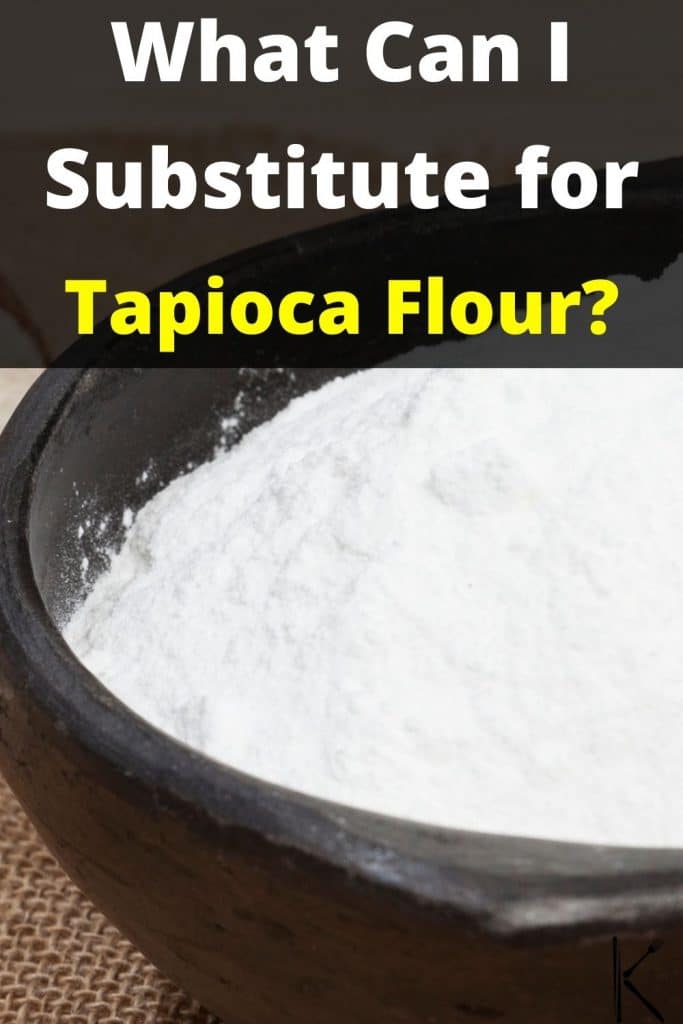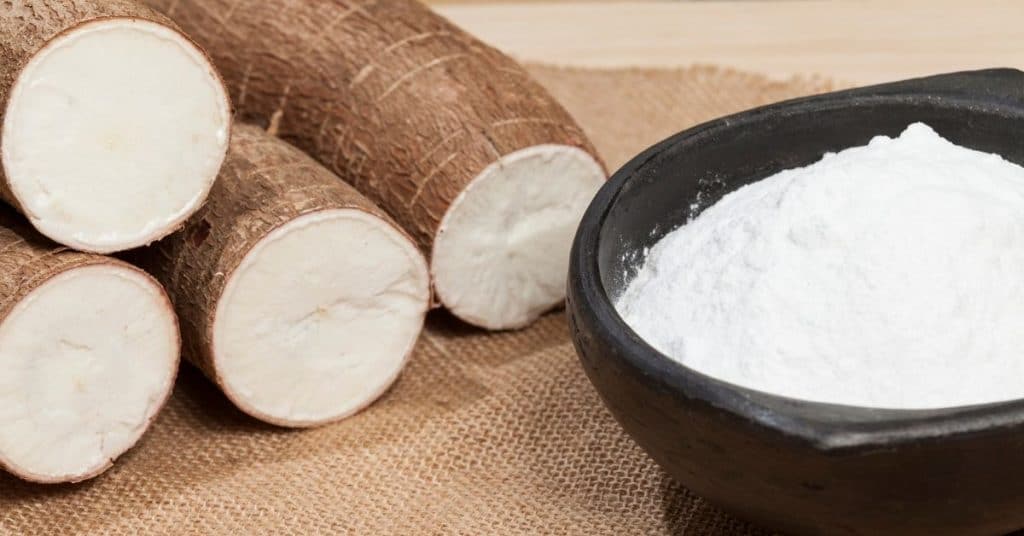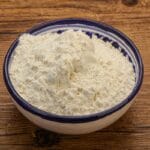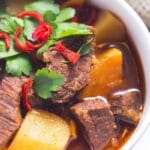There are five alternatives to tapioca flour for baking and thickening: cornstarch, potato flour, arrowroot powder, rice flour, and all-purpose flour. Each option has its own unique properties and may require adjustments in quantity and usage.
If your recipe calls for tapioca flour and you don’t have any, don’t ditch your cooking plans just yet.
There are several alternative products you can substitute for tapioca flour. In this guide, we’ll help you determine which tapioca flour substitute will give you the best results for cooking of baking.
What is Tapioca Flour?
Tapioca flour, also referred to as tapioca starch, has the appearance of fine white powder. It is made from the starchy root vegetable known as yuca or cassava root.
One of the qualities that make the product so popular is that it is gluten-free. This makes it a great choice for gluten-free baking if you have an allergy or gluten intolerance.
Its mild flavor makes it suitable for use in sweet and savory dishes. Similar to cornstarch it works well to thicken sauces, puddings, soups, and stews. It is important to note that you can’t simply substitute tapioca flour for cake flour or wheat flour in a cake recipe. Since it is free of gluten, you will end up with hard, dense baked goods rather than fluffy and airy cakes. Instead, use a gluten-free flour mix that contains a blend of tapioca and other flours.
You can, however, use wheat flour instead of tapioca flour. Read on for more tips.
Best Gluten-Free Tapioca Starch Substitutes
#1. Cornstarch
Cornstarch is easy to find in grocery stores. Although the fine powder looks similar to tapioca starch, it has stronger thickening properties, so you will need to adjust the quantity you use. As with tapioca, it is gluten-free.
When using cornstarch to thicken sauces, soups, and stews, make a smooth paste by adding a little water to the powder and stirring well before adding it to the liquid. This prevents the cornstarch from forming lumps.
Substitute quantity: Use half the amount of cornstarch to replace tapioca flour in your recipe. If the recipe requires 2 tablespoons of tapioca flour, use one tablespoon of cornstarch.
Best for: Thickening sauces, stews, soups, and adding a crumbly texture to baked items. Cornstarch also makes a good coating for fried food when combined with other types of flour.
Related: Cornstarch replacement
#2. Potato Flour
Potato flour or starch is a fine white gluten-free powder. It has a heavier consistency than tapioca flour. This means that when using it in baked items you need to adjust your ratios.
Substitute quantity: When using potato starch to thicken liquids, use the same quantity as the tapioca flour recommended. As with cornstarch, it is best to make a paste with water before adding it to the liquid.
When baking with potato starch, you should not use it on its own but always combine it with other types of flour. Potato flour is very dense and will not yield a fluffy, light, baked product.
You can substitute half of the required tapioca starch for potato starch and use any other type of flour to make up the difference in the volume.
Best for: Thickening sauces, stews, soups. Small quantities can be suitable for baking in combination with other flour types. Potato starch can be used successfully to coat items for frying.
#3. Arrowroot Powder
Similar to tapioca flour, arrowroot is flavorless and gluten-free. Arrowroot starch does not provide the same chewy consistency as tapioca flour and is only suitable for baking when combined with other flour types.
Substitute quantity: Use the same amount of arrowroot to substitute tapioca when used for thickening.
Best for: Thickening sauces, stews, and soups as well as coatings and batters for deep-frying. It can be used in baking only when combined in gluten free flour mixes.
#4. Rice Flour
Made from very finely ground rice, this is a gluten-free flour with a mild flavor. Suitable in sweet and savory applications rice flour can give a delicious soft crumb texture to baked items but only in combination with other flour. It has a strong thickening ability which makes it very dense.
Replacement quantity: Use half as much rice flour as tapioca recommended in your recipe.
Best for: Thickening sauces, stews, soups, and in batters for deep-frying.
Best Tapioca Flour Substitute for Baking
#5. All-purpose Flour
All-purpose flour is a great tapioca flour substitute, but there are a few important factors to consider.
All-purpose flour is made from wheat and is neither wheat-, nor gluten-free. It does not provide the same glossy finish to dishes when used for thickening but gives a slightly dulled color instead.
All-purpose flour also requires a little longer cooking time when used as a thickening agent to cook out the starchy flavor and texture.
Replacement quantity: Substitute all-purpose flour for tapioca in the same quantity as required in the recipe. The texture might differ slightly depending on the dish you are preparing. Make sure you give liquids enough time to cook through completely to avoid a raw floury taste.
Best for: Baking and making sauces if you are not prone to allergies or gluten intolerant.
See more: Wheat Flour Substitute
Measurement Guide When Using a Tapioca Flour Substitute
Use the following guideline when using alternative thickeners as a substitute for tapioca flour. Two tablespoons of tapioca flour are equivalent to:
- 1 Tablespoon of cornstarch
- 1 Tablespoon of potato starch
- 1 Tablespoon of rice flour
- 2 Tablespoons of all-purpose flour
- 1 Tablespoon of Arrowroot
FAQs
Although both tapioca and cassava flour are made from the cassava root, they are two different products. Cassava flour incorporates the entire root which has a higher fiber density and thickening property.
Tapioca flour is made from the starchy part of the plant only, yielding a finer powder with low fiber content. If you use cassava flour as a substitute for tapioca flour keep in mind that the fiber content will cause it to thicken slightly more.
Tapioca flour should not be used to substitute all-purpose wheat flour in the same ratio since too much of it will cause baked items to become gummy. Using tapioca in combination with other flour types in baked items does however offer many benefits including a slightly chewy texture in cakes and a crisp crumb in pie crusts.
Guar gum is available in a fine, off-white color powder. As with tapioca and cornstarch, it is used in cooking for thickening, stabilizing, and emulsifying. It is a good alternative to tapioca flour, especially if you are preparing food to store in the freezer. Guar gum will act as a thickener while its inherent compounds prevent the formation of ice crystals during freezing.
It is very powerful as a thickener and requires only a small amount to replace other thickeners. Start with adding a ¼ of a teaspoon to the pot and increase the amount slightly if it is not thick enough.
Xanthan gum is not the same as tapioca flour. It is a plant-based thickener and is used as a stabilizing or gelling agent. It works as an emulsifier and can be used for thickening.
Xanthan gum has very strong thickening properties so when using it as a tapioca flour substitute to thicken liquids, use only an eighth to a quarter of the required amount. Start with a ¼ of a teaspoon and increase the amount slightly if it is not thick enough.
To substitute cornstarch for tapioca flour, use the same amount of cornstarch as the amount of tapioca flour called for in the recipe. Keep in mind that cornstarch has a slightly different texture and thickening power than tapioca flour, so the final result may be slightly different, but it should still work well as a thickener in most recipes.
Conclusion
Tapioca flour is great for gluten-free cooking, especially to use as a thickener for sauces, soups, pie-fillings, and stews. It is often used in making puddings and as a dredge for deep-frying.
When used for gluten free baked goods, tapioca flour provides a crisp crumb to crusts and biscuits and provides a chewy texture to items such as cakes.
The type of flour best used as a tapioca substitute may depend on what you are using it for. The best tapioca flour substitutes for thickening are cornstarch, potato or rice flour, and arrowroot. The best tapioca flour substitutes for baking are all-purpose flour or a combination of various gluten-free flours.

*image by gonzalocallefotografia.gmail.com/depositphotos









